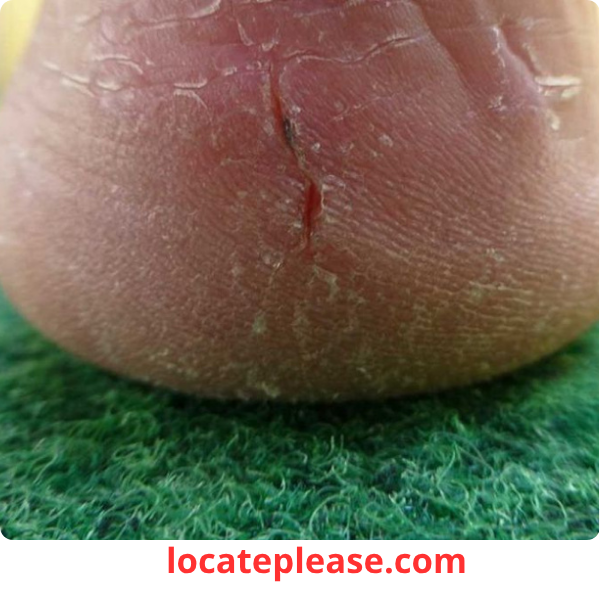You’ve slathered on every foot cream, tried overnight socks, and even soaked your feet in oils — but your cracked heels won’t heal. The pain when you walk, the sight of deep fissures, and the fear of infection can be more than just a nuisance — they’re a warning sign.
Cracked heels, or heel fissures, are more than dry skin. When the skin on your heels splits open — especially if it’s bleeding, painful, or won’t respond to lotions — it’s time to go beyond the bathroom shelf.
Let’s explore why lotion isn’t enough, what’s really causing your cracked heels, and what you can do — including when it’s time to see a doctor.
Why Cracked Heels Happen: It’s More Than Just Dry Skin
Heel fissures occur when the skin on the heel becomes extremely dry, thick, and loses elasticity. As you stand or walk, pressure causes the hardened skin to crack — like a dry riverbed splitting under tension.
While it may start as a cosmetic issue, deep cracks can bleed, become infected, and cause real pain. In severe cases, they can even lead to ulcers, especially in people with diabetes or poor circulation.
Common Causes of Cracked Heels
Lotion alone won’t fix the root problem. These underlying factors are often to blame:
|
Prolonged standing
|
Pressure on hard surfaces thickens and cracks heel skin
|
|
Open-back shoes or sandals
|
Lets heel pad expand sideways, increasing crack risk
|
|
Obesity
|
Extra body weight puts more pressure on the heel pad
|
|
Medical conditions
|
Diabetes, hypothyroidism, psoriasis, and eczema all affect skin health
|
|
Dry environments
|
Cold weather, low humidity, and indoor heating dry out skin
|
|
Poor foot hygiene
|
Lack of exfoliation leads to thick calluses that split
|
Why Lotion Isn’t Working
You’re not doing anything wrong — but most lotions only work on the surface. If your heels are:
- Covered in thick, callused skin
- Cracked deeply
- Bleeding or infected
…then surface-level moisturizers can’t penetrate to where healing is needed.
Think of it like trying to water a plant through a layer of concrete — the moisture never reaches the roots.
What to Do When Lotion Fails: 7 Effective Steps
1. Soak & Soften
- Soak feet in warm water for 10–15 minutes.
- Add Epsom salts (reduces inflammation) or apple cider vinegar (softens skin and fights bacteria).
- Pat dry thoroughly — especially between toes.
2. Exfoliate Gently
- Use a pumice stone, foot file, or electric callus remover to gently buff away thick skin.
- Do this 1–2 times per week — over-scrubbing can make cracks worse.
3. Apply a Heavy-Duty Moisturizer
- Ditch the light lotions. Use thick, occlusive creams like:
- Urea cream (10–20%) – Breaks down thick skin and deeply hydrates
- Lanolin – Natural, deeply penetrating
- Petroleum jelly (Vaseline) – Locks in moisture overnight
- Apply immediately after soaking or showering.
4. Lock in Moisture Overnight
- Slather on your cream, then put on clean cotton socks.
- This creates a “moisture chamber” that boosts absorption.
5. Wear Supportive, Closed-Back Shoes
- Avoid flip-flops and open heels — they let your heel pad spread and crack.
- Choose shoes with good arch support, cushioning, and closed backs.
- Consider orthotic inserts if you’re on your feet all day.
6. Try Natural Remedies (With Caution)
Some home remedies may help — but they’re not magic:
- Honey + coconut oil – Moisturizing and antibacterial
- Mashed banana mask – Vitamins A, D, and E may soften skin
- Aloe vera gel – Soothes and hydrates
⚠️ Don’t use on open, bleeding cracks — risk of infection.
7. Adjust Your Diet
Skin health starts from within. Eat more:
- Omega-3s (salmon, chia seeds) – Reduce inflammation
- Vitamin E (nuts, spinach) – Supports skin repair
- Zinc & vitamin C (citrus, legumes) – Aid collagen production
When to See a Doctor: Red Flags You Can’t Ignore
You don’t have to suffer in silence. See a podiatrist or dermatologist if you have:
✅ Deep, bleeding cracks that won’t heal
✅ Pain while walking or bearing weight
✅ Signs of infection — redness, swelling, pus, warmth
✅ Numbness or tingling — could signal nerve damage (common in diabetes)
✅ No improvement after 2–4 weeks of home care
Special Warning: If You Have Diabetes
Cracked heels are especially dangerous for people with diabetes. Poor circulation and nerve damage (neuropathy) mean:
- You might not feel pain from a deep crack
- Healing is slower
- Infections can spread quickly
🩺 If you have diabetes:
- Check your feet daily
- Never cut calluses yourself
- See a foot specialist regularly
Even a small crack can lead to a foot ulcer or amputation if ignored.
Professional Treatments Your Doctor Might Recommend
If home care fails, your doctor may suggest:
- Prescription-strength urea or salicylic acid creams
- Antibiotics (if infection is present)
- Debridement — safe removal of dead skin by a professional
- Custom orthotics to reduce pressure on heels
- Medical-grade moisturizing dressings
Prevention: Keep Your Heels Smooth & Healthy
✅ Moisturize daily — not just when cracks appear
✅ Exfoliate weekly to prevent callus buildup
✅ Wear supportive shoes and moisture-wicking socks
✅ Stay hydrated — drink plenty of water
✅ Control underlying conditions like diabetes or thyroid issues
Final Thoughts: Cracked Heels Are a Cry for Help — Don’t Ignore Them
Your feet carry you every day. When they start to crack and bleed, it’s not just about appearance — it’s a signal that something’s wrong.
Lotion is a good start, but if it’s not working, it’s time to dig deeper — literally and figuratively.
With the right care, most cracked heels can heal. But if they’re deep, painful, or linked to a health condition, professional help isn’t optional — it’s essential.
So don’t wait.
Soak. Exfoliate. Moisturize.
And if nothing works?
👉 See a doctor.
Your feet — and your health — are worth it.










